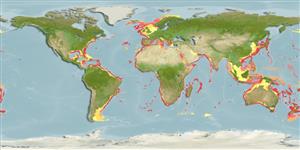sub class Elasmobranchii (ฉลามและกระเบน) (sharks and rays) >
Echinorhiniformes (Bramble sharks) >
Echinorhinidae (Bramble sharks)
Etymology: Echinorhinus: echinos (Gr.), spiny or sea urchin, referring to thorn-like denticles (brambles) on body; rhinus, an ancient name for sharks, from rhine (Gr.), rasp, alluding to a shark’s jagged, rasp-like skin. (See ETYFish); brucus: Latin for caterpillar, presumably referring to “Chenille” or “Chenille de mer” (Sea Caterpillar), local names for this shark along the Atlantic Coast of France (type locality) in the 18th century. (See ETYFish).
More on author: Bonnaterre.
Environment: milieu / climate zone / depth range / distribution range
นิเวศวิทยา
เกี่ยวกับทะเล,น้ำเค็ม สัตว์หน้าดินในเขตน้ำลึก; ระดับความลึก 10 - 900 m (Ref. 27121), usually 350 - 900 m (Ref. 45445). Deep-water; 72°N - 55°S, 98°W - 173°W (Ref. 54427)
Western Atlantic: Virginia, Massachusetts, USA; Venezuela, Argentina. Eastern Atlantic: North Sea to Mediterranean, Morocco to Cape of Good Hope, South Africa. Indian Ocean: India, Mozambique, South Africa. Western Pacific: Japan, southern Australia, New Zealand. Records from Oman and Kiribati uncertain. Apparently absent in the Eastern Pacific (Ref. 6578).
Length at first maturity / ขนาด / น้ำหนัก / Age
Maturity: Lm ?, range 200 - ? cm
Max length : 310 cm TL เพศผู้/กระเทย; (Ref. 247); common length : 200 cm TL เพศผู้/กระเทย; (Ref. 26999)
เงี่ยงครีบหลัง (รวม): 0; ก้านครีบอ่อนที่หาง (รวม): 0; เงี่ยงครีบก้น 0; ก้านครีบอ่อนที่ก้น: 0. The bramble shark Echinorhinus brucus has thorn-like denticles on body which are very large (single denticles up to about 15mm in basal diameter in adults), sparse irregularly distributed and thorn-like with smooth basal margins, some bases fused into compound plates. Dorsal surface dark purplish-grey to brown with white denticles, ventral surface paler; sides and back may have dark spots. Tooth count 20-26/21-26.As with the other member of the family Echinorhinidae, it has a relatively short snout and stout body; two small spineless dorsal fins, close together, towards posterior part of body and originating behind pelvic fin origin. No anal fin and subterminal notch on caudal fin. Small spiracles, very short labial furrows and teeth on both jaws alike, with a central oblique bladelike cusps with up to 3 cusplets on each side (absent in juveniles) (Ref. 247, 6871, 5578).
A rare (Ref. 26346), large, sluggish, deepwater shark found on continental and insular shelves and upper slopes (Ref. 247). Sometimes found in shallow water (Ref. 247). Feeds on smaller sharks, bony fishes, and crabs (Ref. 247). Ovoviviparous (Ref. 205), with 15-26 young in a litter (26346). Never recorded as attacking people. Sometimes hooked by shore anglers (Ref. 5578). Processed into fishmeal. May be used in traditional medicine in southern Africa (Ref. 5578).
Ovoviviparous. 15 to 26 young in a litter (Ref. 26346). Size at birth between 29 and 90 cm. Distinct pairing with embrace (Ref. 205). Size at maturity unknown but adult males of 150 cm and adult females of 213 cm have been reported (Ref. 6871).
Compagno, L.J.V., 1984. FAO Species Catalogue. Vol. 4. Sharks of the world. An annotated and illustrated catalogue of shark species known to date. Part 1 - Hexanchiformes to Lamniformes. FAO Fish. Synop. 125(4/1):1-249. Rome, FAO. (Ref. 247)
IUCN Red List Status (Ref. 130435)
Human uses
การประมง: มีการค้าเพียงเล็กน้อย; การตกปลาเป็นกีฬา: ใช่
ข้อมูลเพิ่มเติม
อ้างอิงการเพาะเลี้ยงสัตว์น้ำประวัติการเพาะเลี้ยงสัตว์น้ำสายพันธุ์พันธุศาสตร์ElectrophoresesอัตราพันธุกรรมโรคการแปรรูปNutrientsMass conversion
ผู้ร่วมมือรูปภาพหลายรูปStamps, Coins Misc.เสียงปลามีพิษ เช่น ปลาปักเป้าความเร็วรูปแบบการว่ายน้ำพื้นที่เหงือกOtolithsสมองวิสัยทัศน์
เครื่องมือ
Special reports
Download XML
แหล่งที่มาจากอินเตอร์เน็ต
Estimates based on models
Preferred temperature (Ref.
123201): 4.1 - 13.9, mean 8.5 °C (based on 1524 cells).
Phylogenetic diversity index (Ref.
82804): PD
50 = 1.0000 [Uniqueness, from 0.5 = low to 2.0 = high].
Bayesian length-weight: a=0.00363 (0.00139 - 0.00949), b=3.13 (2.90 - 3.36), in cm total length, based on LWR estimates for this (Sub)family-body shape (Ref.
93245).
ระดับชั้นอาหาร (Ref.
69278): 4.4 ±0.7 se; based on diet studies.
ความสามารถในการกลับคืนสู่ปกติ (Ref.
120179): ต่ำมาก, เวลาต่ำสุดที่จะทำให้ประชากรเพิ่มขึ้นเป็น 2 เท่าใช้เวลามากกว่า 14 ปี (Fec= 15-24).
Fishing Vulnerability (Ref.
59153): Very high vulnerability (90 of 100).
Climate Vulnerability (Ref.
125649): Moderate vulnerability (38 of 100).
